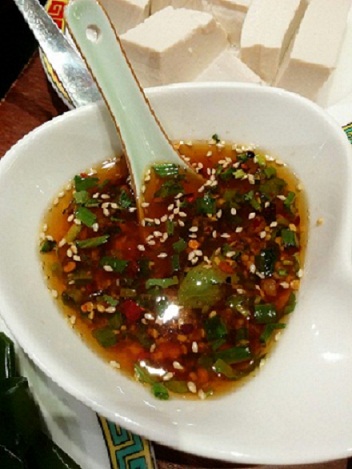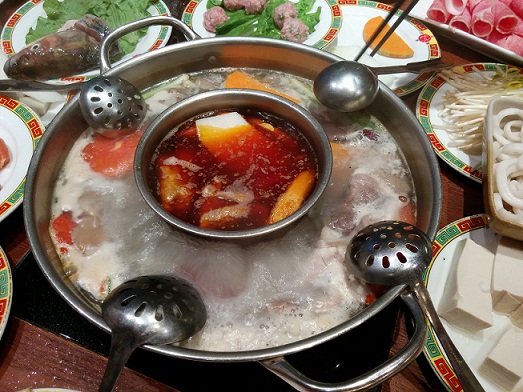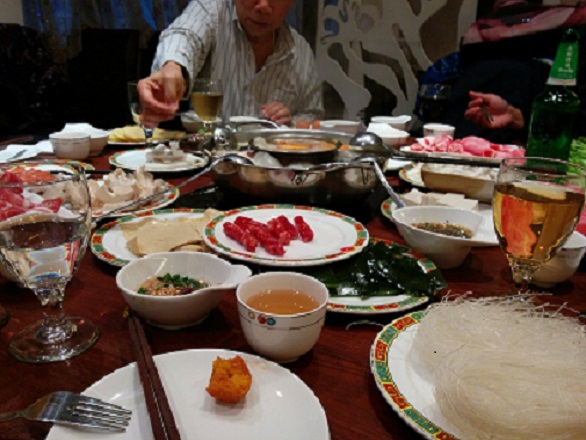The ubiquitous hot pot has made its way around the world, although many may not know the variations of this humble simmering pot dish found in different Asian countries. More than just food, it’s also about people gathering to enjoy a communal meal together. Perfect for the winter, but eaten year round nowadays, hot pot meals are comprised of ingredients centered on a simmering pot of stock placed in the middle of the dining table. Typical ingredients usually include thinly sliced meat (beef and pork are most popular), leafy vegetables, various kinds of tofu and mushrooms, as well as dumplings, which are then dipped into sauce before being consumed.
Growing up as a Chinese kid in Hong Kong and then Canada, I have fond memories of steam rising from the metal pot of delicious broth, the careful timing of when to put the sizzling food in my mouth, and that delectable feeling of being so full I could not eat any more. You think it’s not a lot of food but then you start eating, eat some more, and finally finish it up with some more eating. Whew!
Now living in China, I have the luxury of a wide selection of different hot pot for my perusal. Did you know that there are regional variations of hot pot within China? One of the most famous, and usually thought to be the “original” hot pot is the Chongqing má là huǒ guō (Chinese: 麻辣 – “numb and spicy” hot pot), which is well-known for its spicy soup base, the meats that are used, and the variety of sauces and condiments. Slices of lamb are typically found as a key ingredient. The soup base has the infamous Sichuan pepper added to it, distinguishing it from the mushroom-based broth that is used in other parts of China. I also discovered that Sichuan hot pot includes appetizers on the side, like deep-fried sweet potato slices, which are uncommon to other types of hot pot.
Last month, I jumped at the chance to travel to and eat my way through Sichuan province, and all my Chinese friends warned me of the tongue-numbing, tears-pouring level of fire-from-a-dragon’s-mouth spiciness I would encounter. As I’m the kind of gal that usually asks for “less spicy please” on most things, I was left feeling both anticipatory and apprehensive of this challenge. But there’s also something to be said about being able to say you gave it your best shot!
Sichuan peppers are one of a kind. It’s not jalapeño spicy, nor a wasabi spicy that hits the nose, nor an aromatic herb-and-spice kind of spicy, but one that utterly numbs the tongue with a tingly feeling that can continue to persist even after the burning feeling goes away. As my research revealed, the active ingredient in Sichuan peppers (called hydroxy-alpha-sanshool) apparently activates a specific frequency in the mouth’s tactile receptors, causing a vibration that we perceive as a numbing sensation.
Science aside, my friends and I opted for our hot pot to have both the non-spicy and spicy soup bases, bringing the best of both worlds by having the spicy broth in the central small circular section, and the non-spicy base surrounding it in the larger circular section. It’s a good idea to have the option to switch it up, as we found out how badly our tongues needed relief from the inferno.
Another important aspect of hot pot is knowing how to make a decent dipping sauce, which is typically a mixture of soy sauce, sesame oil, chili, sa cha sauce, vinegar, hoisin sauce, peanut butter, and pickled vegetables. The proportions of each will depend on preference and what you are dipping with, so each sauce will vary from person to person. The key is to have the sauce enhance the taste of the ingredients rather than overpower them.
Final verdict? I’ll be honest – I probably would rather choose the Beijing or Hong Kong (non-spicy) hot pot variants but only because I would be so busy constantly crying and reaching for my glass of water that the whole experience just wouldn’t be pleasant. But if you are one of those people with crazy taste buds and can handle ten degrees of chilis…then by all means, this is one culinary experience you do not want to miss out on.
Looking to try Sichuan hot pot closer to home? Check out the following restaurants.
17th Dock Hot Pot has kept the authentic Sichuan level of spice, and is perfect for those who can handle it, though there’re options for mild broths as well.
Third Floor, Changjiu Tower, 945 Jiaozhou Lu, near Changshou Lu
Baobao Jiao is another jubilant joint with its signature Ganguo Xiangla squid and shrimp fragrant spicy hot pot. Located near Zhongshan Park metro stop.
1550 Dingxi Lu, near Yuyuan Lu
Yuxin Chuan Cai (Yuxin Sichuan Dish) has three locations in the city, but make sure to get ahead of the crowd, it can be packed!
Various locations. Huangpu location: 5/F, Huasheng Building, 399 Jiujiang Lu, near Shanxi Nan Lu
Feeling more of a royal treatment? Hai Di Lao Hotpot is a Sichuan-style hotpot chain which is well-known for its extraordinary service (compared to the usual in China), including free shoulder massages and manicures while you wait for your table. The staff is friendly, the food is fresh and tasty, and if you know to order it, the noodles you can get will come with a kung fu performance.
Various locations. Jing’an location: 3/F, 1068 Beijing Lu, near Jiangning Lu




